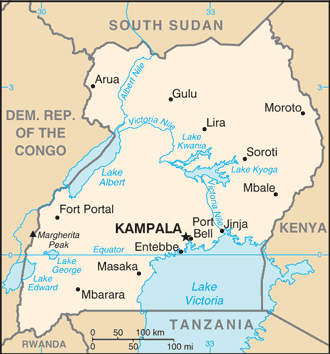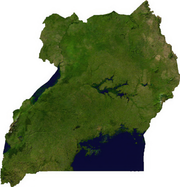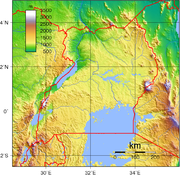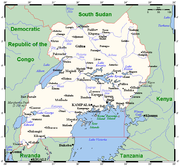
Geography of Uganda
About this schools Wikipedia selection
SOS Children, which runs nearly 200 sos schools in the developing world, organised this selection. A good way to help other children is by sponsoring a child
Uganda is located in Eastern Africa, west of Kenya and east of the Democratic Republic of the Congo. It is in the heart of the Great Lakes region, and is surrounded by three of them, Lake Edward, Lake Albert, and Lake Victoria. While much of its border is lakeshore, Uganda is landlocked with no access to the sea.
Despite being on the equator Uganda is more temperate than the surrounding areas due to its altitude. The country is mostly plateau with a rim of mountains. This has made it more suitable to agriculture and less prone to tropical diseases than other nations in the region. The climate is tropical; generally rainy with two dry seasons (December to February, June to August). It is semiarid East Sudanian savanna in north near Sudan.
Geographic coordinates: 1°00′N 32°00′E
Climate
Statistics
Area:
total: 236 040 km²
land:199 710 km²
water: 36 330 km²
Land boundaries:
total: 2 698 km
border countries: Democratic Republic of the Congo 765 km, Kenya 933 km, Rwanda 169 km, Sudan 435 km, Tanzania 396 km
Elevation extremes:
highest point: Margherita Peak on Mount Stanley 5 110 m
Natural resources: copper, cobalt, hydropower, limestone, salt, arable land
Land use:
arable land: 25%
permanent crops: 9%
permanent pastures: 9%
forests and woodland: 28%
other: 29% (1993 est.)
Irrigated land: 90 km² (1993 est.)
Environment - current issues: draining of wetlands for agricultural use; deforestation; overgrazing; soil erosion; poaching is widespread
Environment - international agreements:
party to: Biodiversity, Climate Change, Desertification, Endangered Species, Hazardous Wastes, Law of the Sea, Marine Life Conservation, Nuclear Test Ban, Ozone Layer Protection, Wetlands
signed, but not ratified: Environmental Modification




